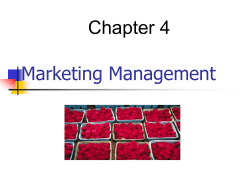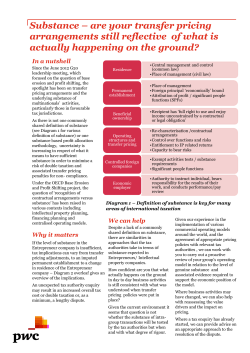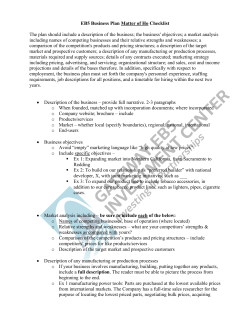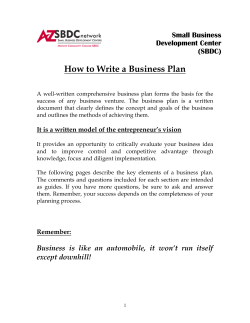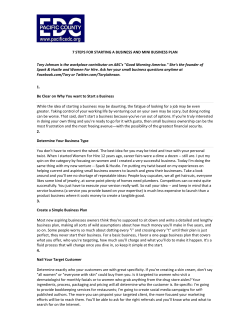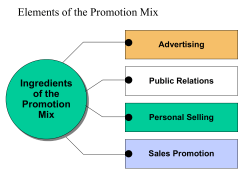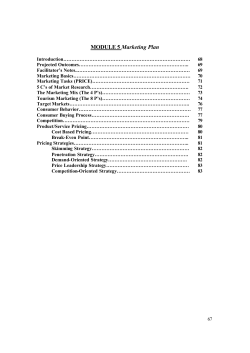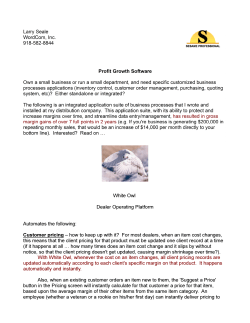
SCANA A Guideline for Preparing a Business Plan Small Business Development Center
The information in this document is taken from: A Guideline for Preparing a Business Plan Published By: UNIVERSITY OF SOUTH CAROLINA Small Business Development Center "Small businesses are big business" and SCANA Table of Contents L EXECUTIVE SUMMARY IL THE INDUSTRY, THE COMPANY, AND ITS PRODUCTS A. The Industry B. The Company C. The Product or Service IIL MARKET RESEARCH AND ANALYSIS A. Customers B. Market Size and Trends C. Competition IV. MARKETING PLAN A. Overall Market Strategy B. Pricing C. Sales Tactics D. Advertising and Promotion V. OPERATING PLAN A. Location B. Facilities and Improvements C. Strategy and Plans D. Labor Force VL MANAGEMENT TEAM A. Organization B. Key Personnel VII. THE FINANCIAL PLAN T here are two basic reasons for preparing an extensive business plan. First, it requires the entrepreneur to thoroughly investigate the factors that will have a bearing on the success of the business. Second, it will enhance the ability of the entrepreneur to secure financing by providing an organized overview of the venture for lenders and investors. It also provides insight into the entrepreneur's ability to define and develop strategies for critical areas of the business. The following outline has been prepared to help the entrepreneur assemble the facts that are essential to good business planning. Complete your business plan using the accompanying outline to ensure that the necessary details are included. Keep in mind that thoroughness, clarity, and rationality of the plan are all factors that will play key roles in successfully financing, starting, and operating your business. Because these guidelines were written to cover a variety of possible businesses, rigid adherence to them is not possible or even desirable for all businesses. Not all parts of all sections will be necessary for each individual's business plan. L Executive Summary The Executive Summary should adequately summarize the entire business plan. The summary should be succinct but specific and detailed in important sections. Keep the prospective audience in mind when creating this section. That is, a potential lender or investor should be able to pick up the business plan, read the executive summary, and then have a concrete idea of what the business will do and how the goals will be achieved. The executive summary will probably be the most read section of the business plan, so it is very crucial not to disregard it. It should capture interest and promote curiosity. In a sense, the executive summary sells the business plan. No rigid guidelines exist pertaining to the appropriate length of the; executive summary. Typically it is between 1 and 3 pages. More important than the length is that this section should be direct and well organized but sufficiently long to convey the mission of the business and the operations in detail. Many business plan writers often write this section last, as it is easier and more precise to summarize the entire plan after the plan is completed. Do not be afraid to continuously revise this section. IL The Industry, the Company, and its Products The purpose of this section is to assist you in describing your business venture in a detailed but succinct manner. You must clearly present the business you are in, the product you will offer, and the nature of your industry. A. THE INDUSTRY Present the current status and prospects for the industry in which the business will operate. Discuss new products and developments, new markets and customers, and any other trends that could affect the business. Identify all sources of information used to describe these trends. B. THE COMPANY Briefly describe what business area your company is in, or intends to enter, what products or services it will offer, and who are or will be its principal customers. Also discuss the ownership and legal form of the company. Consult your attorney for which form of corporation, partnership, or sole proprietorship is best for you. C. THE PRODUCTS OR SERVICES Describe in detail the products or services to be sold, as well as the application of your product or service. Emphasize any unique features of your product or service and highlight differences between what is currently on the market and what you will offer. Define the current state of development of the product or service; include a photograph, if applicable. IlL Market Research and Analysis The purpose of this section is to present enough facts to determine if your product or service has a substantial market in a growing industry and can achieve sales despite a competitive market. It is one of the most important. Almost all subsequent sections of the business plan depend on sales estimates that are developed in this section. The sales levels you project based on the market research and analysis, directly influence the size of the operation, the marketing plan, and the amount of debt and equity capital required. A. CUSTOMERS Discuss who your customers are for the product or service. Who and where are the major purchasers? What is the basis for their purchase decision: price, quality, service, personal contact, or some combination of these factors? B. MARKET SIZE AND TRENDS Describe the primary market for your product, both geographically and in terms of total sales volume. Also, describe the seasonal fluctuations and the potential annual growth of the total market for your product or service, and discuss the major factors affecting that growth (industry trends, economic trends, government policy, population shifts). C. COMPETITION Make a realistic assessment of the strengths and weaknesses of competitive products and services and name the companies that supply them. Compare these competing products or services on the basis of price, performance, service, warranties, and other pertinent features: Present a short discussion of the current advantages and disadvantages of competing products and services and state why they are not meeting customer needs. IV Marketing Plan A. OVERALL MARKETING STRATEGY Describe the general marketing philosophy and strategy of the company. This should be derived from marketing research and evaluation. It should include a discussion of what kinds of customer groups will be targeted for initial, intensive sales promotions as well as which groups will be targeted for later sales efforts. B. PRICING The pricing policy is one of the most important decisions you will have to make. The price must be right to penetrate the market, maintain a market position, and produce profits. Discuss prices to be charged for your product or service, and compare your pricing policy with that of your major competitors. Continuously re-evaluate your pricing decisions and do not be afraid to change them. Pricing is an iterative process. Also, remember that pricing may confer an image. Is that image consistent with the mission of the business? C. SALES TACTICS Describe the methods that will be used to make sales and distribute the product or service. Will the company use its own sales force, independent sales representatives, or distributors? Discuss the margins to be given to retailers, wholesalers, and salesmen and compare them to those of your competition. D. ADVERTISING AND PROMOTION Describe approaches the company will use to bring its product to the attention of prospective purchasers. The schedule and cost for advertising and promotion should be presented. If advertising and promotion will be a significant expense item, an exhibit of how and when these costs will be incurred should be included. V. Operating Plan The operating plan should describe facilities, location, space requirements, capital equipment, and labor force that are required to provide the company's product or service. The discussion guidelines given below are general enough to cover different businesses. Only those that are relevant to your particular business should be addressed in your business plan. A. LOCATION Describe the planned location of the business and discuss the advantages and disadvantages of the site in terms of wage rates; labor availability; proximity to customers and suppliers; access to wholesalers, distributors, and transportation; state and local taxes and laws; utilities; and zoning. B. FACILITIES AND IMPROVEMENTS If yours is an existing business, describe the facilities currently used. If your firm is new, describe how and when the facilities to start business will be acquired. Discuss how and when space and equipment will be expanded to the capacity required for future sales projections. Discuss any plans to add to or improve existing space. Explain future equipment needs and indicate the cost and timing of such acquisitions. C. STRATEGY AND PLANS Describe the process involved in production of your product or service. Also present a plan that shows cost-volume information at various sales levels of operation with a breakdown of material, labor, purchased components, and overhead. Manufacturers should briefly describe their approach to quality control, production control, and inventory control. Explain the quality control and inspection procedures the company will use to minimize service problems and ensure customer satisfaction. D. LABOR FORCE Exclusive of management functions, does the local labor force have the necessary skills, in sufficient quantity and quality, to produce the product? If their skills are inadequate, describe the training that you would use to upgrade them. VI Management Team The management team is the key to turning a good idea into a successful business. Bankers and investors look for a committed management team with a balance of technical, managerial, and business skills. The proposal should include a description of the organizational structure, key management personnel and their primary duties, and the board of directors, if applicable. A. ORGANIZATION In a table, present the key management roles in the company and the individual who will fill each position. Discuss any current or past situations where the management personnel have worked together, and indicate how their skills complement each other and result in an effective management team. B. KEY PERSONNEL Describe the duties and responsibilities of each key member of the management team. For each individual, include a brief statement of career highlights that focuses on his or her ability to perform the assigned role. A complete resume for each member should be included as an exhibit to the business plan. VII. The Financial Plan The financial plan is basic to the evaluation of a business opportunity and should represent your best estimate of future operations. It can also serve as an operating plan for your management team. In developing a financial plan, several basic forecasts must be prepared. Many decisions will be based on what you present here. At the appropriate time, your advisors may recommend some changes, but it is vitally important that you apply your best efforts in formulating these forecasts. The financial plan typically would include a • • • • Source and uses of funds Projected income statements Projected balance statements Projected cash flow statements
© Copyright 2025
